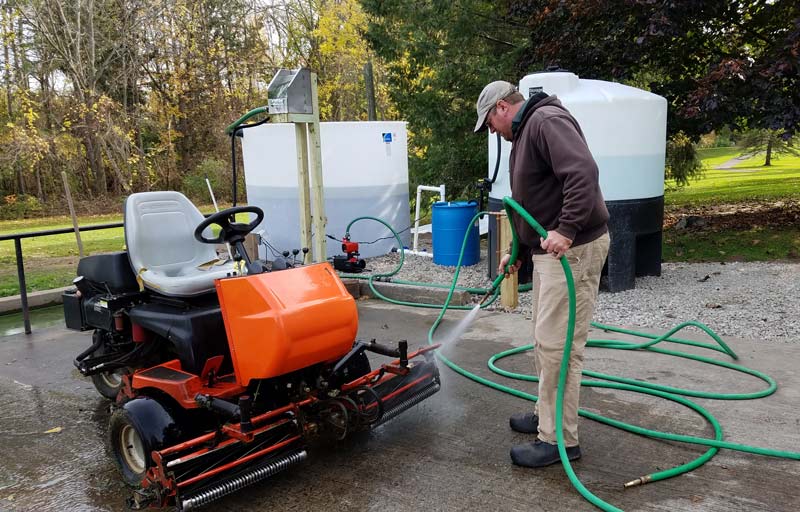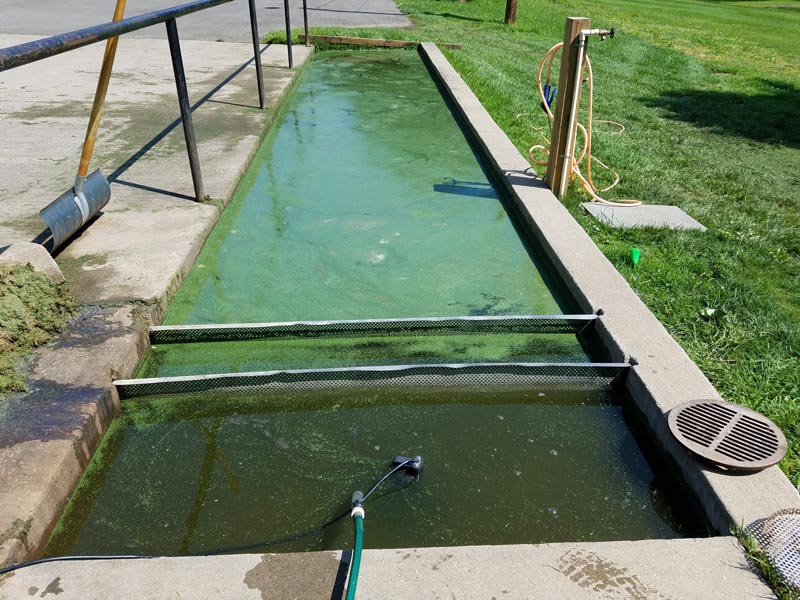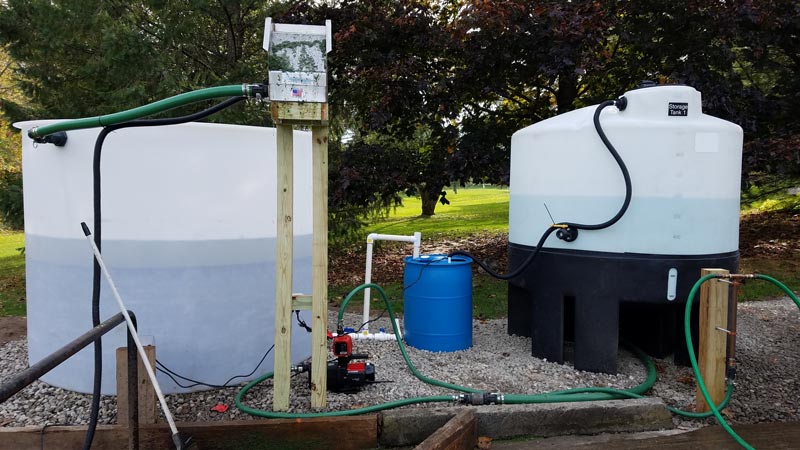
An early test run of the closed-loop equipment washing station at Locust Hill Country Club in Pittsford, N.Y. Photos courtesy of Rick Slattery
Rick Slattery, the golf course superintendent at Locust Hill Country Club in Pittsford, N.Y., used to wash off his equipment like many of us — he had a wash pad with a drain that flowed into a septic tank.
Over the years, he noticed that a lot of water was used during the washing process. In addition, Slattery had occasionally noticed a foul odor when he wandered into a nearby forested area where the septic drains were directed. The 34-year GCSAA member hadn’t viewed either of these issues as worthy of an expensive upgrade, but he reconsidered when the wash pad at Locust Hill found itself in an environmental spotlight.
After a required visit, Audubon International recommended that Slattery look into installing a self-contained equipment washing system that would capture and recycle wastewater. His first concern at the suggestion was cost — he knew some of these stations could run more than $50,000, which just wasn’t realistic at Locust Hill at that time. Still, Slattery liked the idea of a self-contained system. He started thinking about options, and that thinking led to some creative engineering.
Slattery reached out to the New York State Department of Environmental Conservation, which directed him to the New York Green Business program. The latter group manages the Pollution Prevention Institute at the Rochester Institute of Technology, which offers incentives for businesses and other entities to make advances in sustainable practices. That’s right — a government entity that exists to provide funding and assistance for environment-related initiatives, not to look for mistakes and apply fines.
It was a perfect match. The Rochester Institute of Technology stepped up to provide funding for research to develop a low-cost, self-contained equipment washing station.

Two screens pre-filter rinsate before it gets to the pump (bottom of photo), which then transfers it up into the system’s sand filter. The simple air hose shown at right in the photo is used to blow clippings off equipment with compressed air before washing.

The main components of the equipment washing system. In addition to cutting water use and the associated costs, the setup has decreased the amount of contaminated rinsate and organic matter the course releases into the environment by 90 percent. Superintendent Rick Slattery estimates the cost for the entire system was less than $6,000.
The first change that was made was to use air pressure to blow clippings off the equipment in a nearby vegetated area. Slattery found that this step alone reduced water use by 50 percent compared with what Locust Hill had been using previously.
Next, Slattery began using different nozzles to wash the equipment, which resulted in almost another 10 percent reduction in water use.
The self-contained wash pad prototype, first evaluated in 2017, allowed for most of its components to be purchased from a local hardware store, for a total cost of about one-tenth of what Slattery likely would have paid a contractor.
View the schematic of the prototype of the closed-loop equipment washing system at Locust Hill Country Club.
The system’s primary component is a slow sand filtration tank, which was familiar to engineers at the University of Buffalo (another cooperator that joined the cause). The Rochester Institute of Technology and the University of Buffalo also provided graduate student research assistants who used the project as part of their degree completion.
The system is set up so that water used to wash the equipment passes through the sand filtration system and flows to a tank, where it is held until it is reused for equipment washing. This system has reduced Locust Hill’s reliance on municipal water for equipment washing from 30,000 gallons per month to 3,000 gallons per month.
Slattery’s resolve to make his equipment wash pad more environmentally compatible has attracted plenty of attention. He has been contacted by golf courses, car washes and others that manage grey water in New York — and, more recently, in other parts of the country — to gather ideas for their facilities.

Rick Slattery, superintendent at Locust Hill Country Club. The 18-hole private course — located about 5 miles from Rochester, N.Y. — has been a Certified Audubon Cooperative Sanctuary since 2014.
Slattery says he is most proud of how many entities got involved in the effort — Locust Hill Country Club, Audubon International, the New York Green Business Program, the Rochester Institute of Technology, the University of Buffalo and the New York State Turfgrass Association.
In short, filling an environmental “gap” at Locust Hill resulted in a cooperative effort that not only improved the golf course, but ultimately helped solve similar quandaries at golf courses and other facilities in New York and outside the state. And, in the process of solving a wash pad problem, the venture also offered a project to students that ultimately helped advance their education. Slattery’s initiative to do something the right way led to nothing but environmental and organizational positives.
Jack Fry, Ph.D., is a professor of turfgrass science at Kansas State University, currently working at the school’s Research and Extension Center in Olathe, Kan. He is a 22-year educator member of GCSAA.